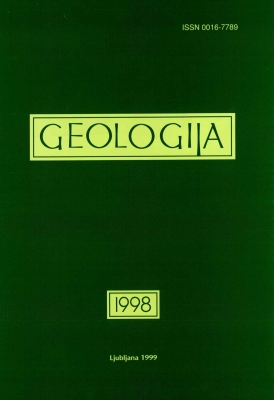Pliocene Aquifers - the Source of drinking Water for Ptuj and Ormož Region, Slovenia
DOI:
https://doi.org/10.5474/geologija.1998.017Abstract
The city of Ptuj and its larger surrounding areas are supplied with drinking water from Dravsko polje with the groundwater pumping station in Skorba. The groundwater is located in Quatemary gravel deposits of the Drava river, relatively close under the surface (7-12.5 m), and is contaminated with nitrates and pesticides due to intensive agricultural activities in the area. These facts prompted Komunalno podjetje Ptuj to engage the Geological Survey in Ljubljana to investigate the possibilities for extracting high-quality drinking water from greater depths. Disposable geological data and investigations of deep geological structures located numerous early Pliocene waterbearing gravel layers of considerable thickness (10-25 m), separated by impermeable clay layers, in the eastern part of Dravsko polje and western part of Ptujsko polje. These water-bearing layers crop out in Slovenske gorice, north and north-east of Ptuj, where they are recharged by precipitation. The investigation in 1995-96 comprised exploratory drilling, electric logging, test pumping and water quality analyses and included 3-4 water-bearing Pliocene gravel layers in Skorba. Three wells of 150-155 m were drilled, in which the upper, contaminated grundwater in Quaternary gravel is sealed with cemented Steel casing, and the groundwater in Pliocene gravel layers is captured with plastic filter casing. The thickness of Pliocene water-bearing strata in the wells ranges from 50 to 57 m, and the well yield is 20-23 l/s. Together, the three wells yield more than 60 l/s of water, and have been exploited without interruption since the beginning of 1996. According to corresponding analyses, the ground water is chemically and bacteriologically unpolluted. It contains no pesticides and a very low concentration of nitrates (under 1 mg N/l). The concentrations of all pesticides monitored, including atrazine and desetilatrazine, which are constantly present in the ground water of Dravsko and Ptujsko polje, were smaller than the detection limit of applied analytical methods. In this way, a high-quality drinking water supply was provided for Ptuj and its surroundings.Downloads
How to Cite
Žlebnik, L., & Drobne, F. (1998). Pliocene Aquifers - the Source of drinking Water for Ptuj and Ormož Region, Slovenia . Geologija, 41(1), 339–354. https://doi.org/10.5474/geologija.1998.017
Issue
Section
Articles

